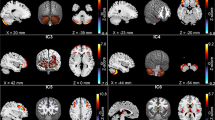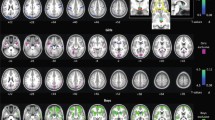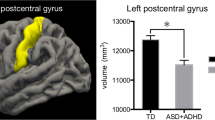Abstract
Attention deficit hyperactivity disorder, combined type (ADHD-CT) is associated with spatial working memory deficits. These deficits are known to be subserved by dysfunction of neural circuits involving right prefrontal, striatal and parietal brain regions. This study determines whether decreased right prefrontal, striatal and parietal activation with a mental rotation task shown in adolescents with ADHD-CT is also evident in children with ADHD-CT. A cross-sectional study of 12 pre-pubertal, right-handed, 8–12-year-old boys with ADHD-CT and 12 pre-pubertal, right-handed, performance IQ-matched, 8–12-year-old healthy boys, recruited from local primary schools, was completed. Participants underwent functional magnetic resonance imaging while performing a mental rotation task that requires spatial working memory. The two groups did not differ in their accuracy or response times for the mental rotation task. The ADHD-CT group showed significantly less activation in right parieto-occipital areas (cuneus and precuneus, BA 19), the right inferior parietal lobe (BA 40) and the right caudate nucleus. Our findings with a child cohort confirm previous reports of right striatal-parietal dysfunction in adolescents with ADHD-CT. This dysfunction suggests a widespread maturational deficit that may be developmental stage independent.
This is a preview of subscription content, access via your institution
Access options
Subscribe to this journal
Receive 12 print issues and online access
$259.00 per year
only $21.58 per issue
Buy this article
- Purchase on Springer Link
- Instant access to full article PDF
Prices may be subject to local taxes which are calculated during checkout

Similar content being viewed by others
References
King JA, Tenney J, Rossi V, Colamussi L, Burdick S . Neural substrates underlying impulsivity. Ann NY Acad Sci 2003; 1008: 160–169.
Schulz KP, Newcorn JH, Fan J, Tang C, Halperin JM . Brain activation gradients in ventrolateral prefrontal cortex related to persistence of ADHD in adolescent boys. J Am Acad Child Adolesc Psychiatry 2005; 44: 47–54.
Silk T, Vance A, Rinehart N, Egan GO, Boyle M, Cunnington R et al. Fronto-parietal activation in ADHD, combined type: fMRI study. Br J Psych 2005; 187: 282–283.
Konrad K, Neufang S, Hanisch C, Fink GR, Herpetz-Dahlmann B . Dysfunctional attentional networks in children with ADHD: evidence from an event-related fMRI study. Biol Psychiatry 2006; 59: 643–651.
Sowell ER, Thompson PM, Wellcome SE, Henkenius AL, Toga AW, Peterson BS . Cortical abnormalities in children and adolescents with ADHD. Lancet 2003; 362: 1699–1707.
Mesulam MM . Large-scale neurocognitive networks and distributed processes for attention, language and memory. Ann Neurol 1990; 28: 597–613.
Bush G, Valera EM, Seidman LJ . Functional neuroimaging of ADHD: a review and suggested future directions. Biol Psychiatry 2005; 57: 1273–1284.
Durston S, Tottenham NT, Thomas KM, Davidson MC, Eigsti I, Yang Y et al. Differential patterns of striatal activation in young children with and without ADHD. Biol Psychiatry 2003; 53: 871–878.
Vaidya CJ, Austin G, Kirkorian G, Ridlehuber HW, Desmond JE, Glover GH . Selective effects of methylphenidate in ADHD: an fMRI study. Proc Natl Acad Sci USA 1998; 95: 14494–14499.
Rubia K, Overmeyer S, Taylor E, Brammer M, Williams SC, Simmons A . Hypofrontality in ADHD during higher-order motor control: a study with fMRI. Am J Psychiatry 1999; 156: 891–896.
Bush G, Frazier JA, Rauch SL, Seidman LJ, Whalen PJ, Jenike MA et al. Anterior cingulated cortex dysfunction in ADHD revealed by fMRI and the counting stroop. Biol Psychiatry 1999; 45: 1542–1552.
Martinussen R, Hayden J, Hogg-Johnson S, Tannock R . A meta-analysis of working memory impairments in children with ADHD. J Am Acad Child Adolesc Psychiatry 2005; 44: 377–384.
Gathercole SE, Alloway TP . Practitioner review: short-term and working memory impairments in neurodevelopmental disorders: diagnosis and remedial support. J Child Psychol Psychiatry 2006; 47: 4–15.
Rapport MD, Scanlan SW, Denney CB . ADHD and scholastic achievement: a model of dual developmental pathways. J Child Psychol Psychiatry 1999; 40: 1169–1183.
Awh E, Jonides J . Overlapping mechanisms of attention and spatial working memory. Trends Cogn Sci 2001; 5: 119–126.
Postle BR . Distraction-spanning sustained activity during delayed recognition of locations. Neuroimage 2006; 30: 950–962.
Shah P, Miyake A . The separability of working memory resources for spatial thinking and language processing: an individual differences approach. J Exp Psych: Gen 1996; 125: 4–27.
Beauchamp MA, Lee KE, Haxby JV . Parallel visual motion processing streams for manipulable objects and human movements. Neuron 2002; 34: 149–159.
Small DM, Gitelman DR, Gregory MD . The posterior cingulate and medial prefrontal cortex mediate the anticipatory allocation of spatial attention. Neuroimage 2003; 18: 633–641.
Booth JR, Burman DD, Meyer JR, Lei Z, Trommer BL, Davenport ND et al. Larger deficits in brain networks for response inhibition than for visual selective attention in ADHD. J Child Psychol Psych 2005; 46: 94–111.
Brandeis D, van Leeuwen TH, Rubia K, Vitacco D, Steger J, Pascual-Marqui RD et al. Neuroelectric mapping reveals precursor of stop failures in children with attention deficits. Behav Brain Res 1998; 94: 111–125.
van Leeuwen TH, Steinhausen HC, Overtoom CC, Pascual-Marqui RD, van't Klooster B, Rothenberger A et al. The continuous performance test revisited with neuroelectric mapping: impaired orienting in children with attention deficits. Behav Brain Res 1998; 94: 97–110.
Johnstone SJ, Barry RJ . Auditory event-related potentials to a two-tone discrimination paradigm in attention deficit hyperactivity disorder. Psychiatry Res 1996; 64: 179–192.
Colby CL, Duhamel JR, Goldberg ME . Ventral intraparietal area of the macaque: anatomic location and visual response properties. J Neurophys 1993; 69: 902–914.
Colby CL, Duhamel JR, Goldberg ME . The analysis of visual space by the lateral intraparietal area of the monkey. Prog Brain Res 1993; 95: 307–316.
Conners CK . Conners' Rating Scales, Revised. Multi-Health Systems: New York, 1997.
Silverman WK, Albano AM . Anxiety Disorders Interview Schedule for DSM-IV. Graywind: Texas, 1996.
Wechsler D . Wechsler Intelligence Scale for Children, 4th edn. Psychological Corporation: San Antonio TX, 2004.
Achenbach TM, Edelbrock CS . Manual for the Child Behaviour Checklist and Behaviour Profile. University of Vermont: Burlington, 1983.
Burgund ED, Kang HC, Kelly JE, Buckner RL, Snyder AZ, Petersen SE et al. The feasibility of a common stereotactic space for children and adults in fMRI studies of development. Neuroimage 2002; 17: 184–200.
Kang HC, Burgund ED, Lugar HM, Petersen SE, Schlaggar BL . Comparison of functional activation foci in children and adults using a common stereotactic space. Neuroimage 2003; 19: 16–28.
Thiel CM, Zilles K, Fink GR . Cerebral correlates of alerting, orienting and reorienting of visuospatial attention: an event-related fMRI study. Neuroimage 2004; 21: 318–328.
Casey BJ, Davidson MC, Hara Y, Thomas KM, Martinez A, Galvan A et al. Early development of subcortical regions involved in non-cued attention switching. Dev Sci 2004; 7: 534–542.
Konrad K, Neufang S, Thiel CM, Specht K, Hanisch C, Fan J et al. Development of attentional networks: an fMRI study in children and adults. Neuroimage 2005; 28: 429–439.
Mesulam MM . A cortical network for directed attention and unilateral neglect. Ann Neurol 1981; 10: 309–325.
Corbetta M, Miezin FM, Shulman GL, Petersen SE . A PET study of visuospatial attention. J Neurosci 1993; 3: 1202–1226.
Nobre AC, Sebestyen GN, Gitelman DR, Mesulam MM, Frackowiak RS, Frith CD . Functional localization of the system for visuospatail attention using PET. Brain 1997; 120: 515–533.
Gitelman DR, Nobre AC, Parrish TB, LaBar KS, Kim YH, Meyer JR et al. A large-scale distributed network for covert spatial attention: further anatomical delineation based on stringent behavioural and cognitive controls. Brain 1999; 122: 1093–1106.
Carter CS, Krener P, Chaderjian M, Northcutt C, Wolfe V . Asymmetrical visual-spatial attentional performance in ADHD: evidence for a right hemispheric deficit. Biol Psychiatry 1995; 37: 789–797.
Schulz KP, Tang CY, Fan J, Marks DJ, Cheung AM, Newcorn JH et al. Differential prefrontal cortex activation during inhibitory control in adolescents with and without childhood ADHD. Neuropsychol 2005; 12: 390–412.
Mostofsky SH, Rimrodt SL, Schafer JGB, Boyce A, Goldberg MC, Pekar JJ et al. Atypical motor and sensory cortex activation in ADHD: a fMRI study of simple sequential finger tapping. Biol Psychiatry 2005; 59: 48–56.
Vaidya CJ, Bunge SA, Dudukovic NM, Zalecki CA, Elliot GR, Gabrieli JDE . Altered neural substrates of cognitive control in childhood ADHD: evidence from fMRI. Am J Psychiatry 2005; 162: 1605–1613.
Castellanos FX, Giedd JN, Eckburg P . Quantitative morphology of the caudate nucleus in ADHD. Am J Psychiatry 1994; 151: 1792–1796.
Castellanos FX, Lee PP, Sharp W, Jeffries NO, Greenstein DK, Clasen LS et al. Developmental trajectories of brain volume abnormalities in children and adolescents with ADHD. JAMA 2002; 288: 1740–1748.
Alexander GE, DeLong MR, Strick PL . Parallel organization of functionally segregated circuits linking basal ganglia and cortex. Ann Rev Neurosci 1986; 9: 357–381.
Volkow ND, Fowler JS, Wang GJ, Ding YS, Gatley JS . Role of dopamine in the the therapeutic and reinforcing effects of methylphenidate in humans: results from imaging studies. Eur Neuropsychopharm 2002; 12: 557–566.
Ashtari M, Kumra S, Bhaskar SL, Clarke T, Thaden E, Cervellione KL et al. ADHD: a preliminary diffusion tensor imaging study. Biol Psychiatry 2005; 57: 448–455.
Pliszka SR . The neuropsychopharmacology of attention-deficit/hyperactivity disorder. Biol Psychiatry 2005; 57: 1385–1390.
Pliszka SR, McCracken JT, Maas JW . Catecholamines in attention-deficit hyperactivity disorder: current perspectives. J Am Acad Child Adolesc Psychiatry 1996; 35: 264–272.
Castellanos FX, Tannock R . Neuroscience of ADHD: the search for endophenotypes. Nat Rev Neurosci 2002; 3: 617–628.
Ando J, Ono Y, Wright MJ . Genetic structure of spatial and verbal working memory. Behav Genet 2001; 31: 615–624.
Martinussen R, Hayden J, Hogg-Johnson S, Tannock R . A meta-analysis of working memory impairments in children with attention-deficit/hyperactivity disorder. J Am Acad Child Adolesc Psychiatry 2005; 44: 377–384.
Arnsten AFT . Catecholamine modulation of prefrontal cortical cognitive function. Trends Cogn Sci 1998; 2: 436–447.
Kempton S, Vance A, Maruff P, Luk E, Costin J, Pantelis C . Executive function and attention deficit hyperactivity disorder: stimulant medication and better executive function performance in children. Psychol Med 1999; 29: 527–538.
Daly G, Hawi Z, Fitzgerald M, Gill M . Mapping susceptibility loci in attention deficit hyperactivity disorder: preferential transmission of parental alleles at DAT1, DBH and DRD5 to affected children. Mol Psychiatry 1999; 4: 192–196.
Parasuraman R, Greenwood P, Kumar R, Fossella J . Beyond heritability: neurotransmitter genes differentially modulate visuospatial attention and working memory. Psychol Sci 2005; 16: 200–207.
Acknowledgements
This work was supported by the Eric Ormond Baker Trust, the National Health and Medical Research Council (384419) and the Royal Children's Hospital staff and patients. RC is supported by a Fellowship of the NHMRC (217025). TS is supported by a Fellowship of the Australian Rotary Health Research Fund.
Author information
Authors and Affiliations
Corresponding author
Rights and permissions
About this article
Cite this article
Vance, A., Silk, T., Casey, M. et al. Right parietal dysfunction in children with attention deficit hyperactivity disorder, combined type: a functional MRI study. Mol Psychiatry 12, 826–832 (2007). https://doi.org/10.1038/sj.mp.4001999
Received:
Revised:
Accepted:
Published:
Issue Date:
DOI: https://doi.org/10.1038/sj.mp.4001999
Keywords
This article is cited by
-
Single-dose effects of methylphenidate and atomoxetine on functional connectivity during an n-back task in boys with ADHD
Psychopharmacology (2023)
-
Working memory and reaction time variability mediate the relationship between polygenic risk and ADHD traits in a general population sample
Molecular Psychiatry (2022)
-
Detecting microstructural white matter abnormalities of frontal pathways in children with ADHD using advanced diffusion models
Brain Imaging and Behavior (2020)
-
ADHD and Comorbid Developmental Coordination Disorder: Implications and Recommendations for School Psychologists
Contemporary School Psychology (2018)
-
Altered gray matter organization in children and adolescents with ADHD: a structural covariance connectome study
Translational Psychiatry (2016)



